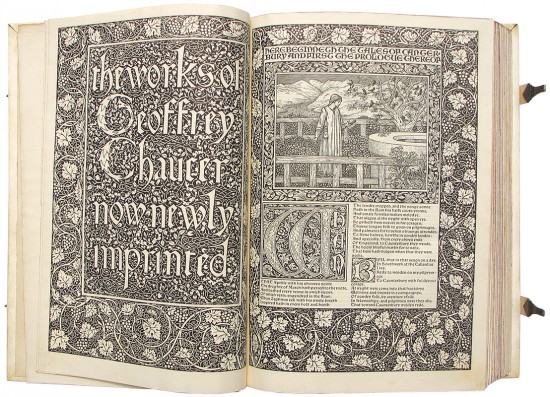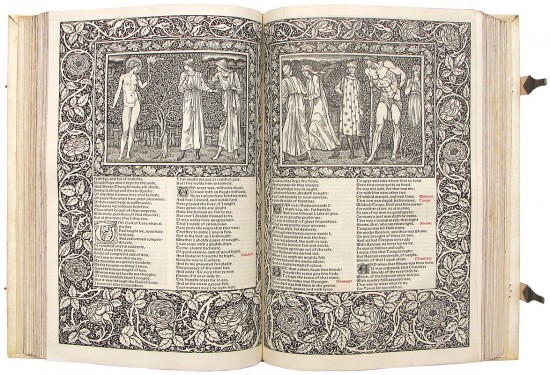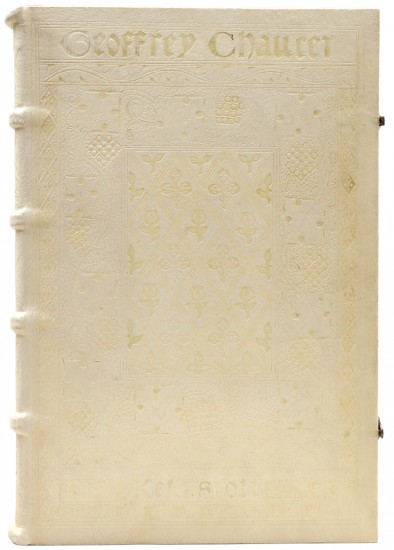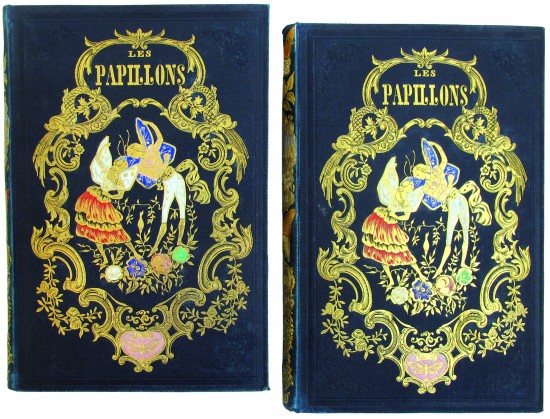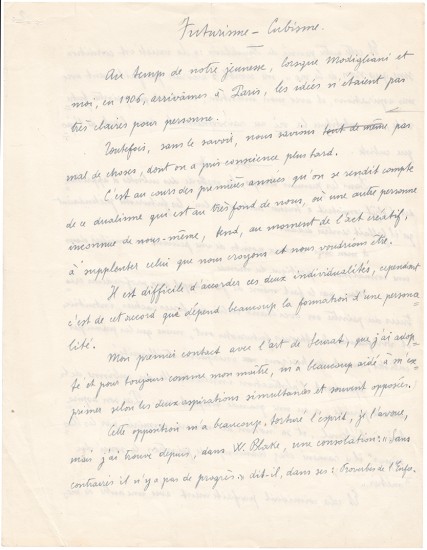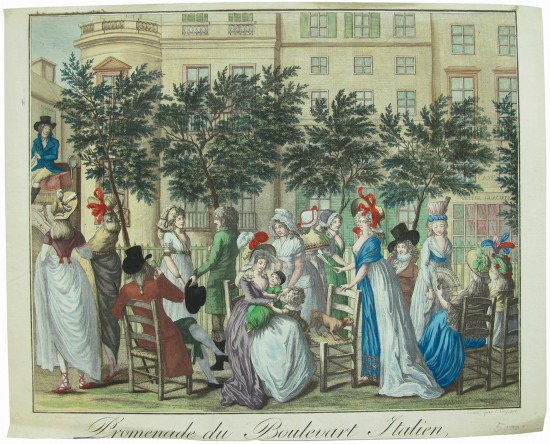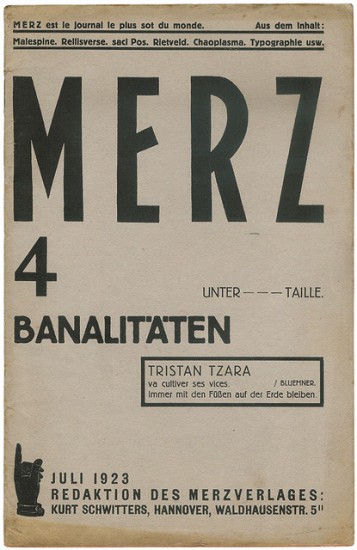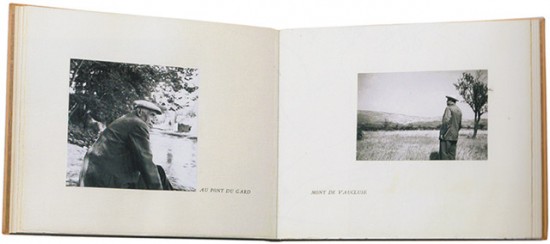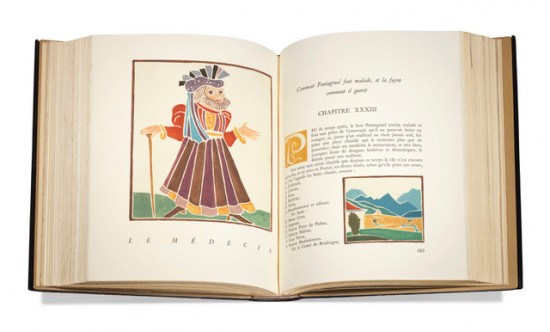The Works of Geoffrey Chaucer now newly imprinted
Kelmscott Press. Chaucer, Geoffrey
Hammersmith. Kelmscott Press. 1896
Sold
One of 50 copies in the de luxe Doves' binding, executed in 1897, from the edition of 425 copies on paper.
The binding is after a design by William Morris, reinterpreting (among others) a binding by Ulrich Schreier for a 1478 Koberger Bible. Morris had planned four alternate bindings (other than the usual holland-backed blue boards) although only the present was completed. Cockerell's Kelmscott bibliography lists 48 copies of the Chaucer bound in pigskin in 1896 and 1897 but some copies were bound after this date (Douglas Cockerell left the Doves Bindery in November 1897) but were not included in the bibliography. Copies vary in the tooling used for the upper cover with pomegranate tools used for some examples; the majority of copies use the field of rose and fleur-de-lys tools as here.
The most ambitious and magnificent book of the Press, the Kelmscott Chaucer was four years in the making. Morris designed the watermark for the paper, which was copied from an Italian incunable in Morris’s collection and made entirely of linen by Batchelor. It took several requests before Clarendon Press granted permission to use Skeat’s new edition of Chaucer.
Burne-Jones devoted all his Sundays for almost three years to the work, and Morris came to talk with him as he drew. As the artist worked he increased the number of proposed illustrations from 48 to 60 to 72 to 87, and Morris accepted each change. The process of adapting the drawings to the woodblock, and engraving them, was entrusted to W. H. Hooper and R. Catterson-Smith, with Burne-Jones closely supervising every detail.
A work described as 'perfect ... both in design and in the quality of the printing ... the last and the most magnificent, the Kelmscott Chaucer ... '. (Printing and the Mind of Man, pg. 223).
'The finest book ever printed - if W. M. had done nothing else it would be enough ...'. (Burne-Jones).
' ... not only the most important of the Kelmscott Press's productions; it is also one of the great books of the world. Its splendour ... can hardly be matched among the books of the time ...'. (Ray, The Illustrator and the Book in England).
[Peterson A40; Ray 258; The Artist and the Book 45; see PMM 367].
The binding is after a design by William Morris, reinterpreting (among others) a binding by Ulrich Schreier for a 1478 Koberger Bible. Morris had planned four alternate bindings (other than the usual holland-backed blue boards) although only the present was completed. Cockerell's Kelmscott bibliography lists 48 copies of the Chaucer bound in pigskin in 1896 and 1897 but some copies were bound after this date (Douglas Cockerell left the Doves Bindery in November 1897) but were not included in the bibliography. Copies vary in the tooling used for the upper cover with pomegranate tools used for some examples; the majority of copies use the field of rose and fleur-de-lys tools as here.
The most ambitious and magnificent book of the Press, the Kelmscott Chaucer was four years in the making. Morris designed the watermark for the paper, which was copied from an Italian incunable in Morris’s collection and made entirely of linen by Batchelor. It took several requests before Clarendon Press granted permission to use Skeat’s new edition of Chaucer.
Burne-Jones devoted all his Sundays for almost three years to the work, and Morris came to talk with him as he drew. As the artist worked he increased the number of proposed illustrations from 48 to 60 to 72 to 87, and Morris accepted each change. The process of adapting the drawings to the woodblock, and engraving them, was entrusted to W. H. Hooper and R. Catterson-Smith, with Burne-Jones closely supervising every detail.
A work described as 'perfect ... both in design and in the quality of the printing ... the last and the most magnificent, the Kelmscott Chaucer ... '. (Printing and the Mind of Man, pg. 223).
'The finest book ever printed - if W. M. had done nothing else it would be enough ...'. (Burne-Jones).
' ... not only the most important of the Kelmscott Press's productions; it is also one of the great books of the world. Its splendour ... can hardly be matched among the books of the time ...'. (Ray, The Illustrator and the Book in England).
[Peterson A40; Ray 258; The Artist and the Book 45; see PMM 367].
pp. (iv), 554. Folio. (436 x 300 mm). Ornamental woodcut title, 14 large borders, 18 different frames rfor the illustrations, 26 initials designed by William Morris and 87 wood cut illustrations designed by Sir Edward Burne-Jones and engraved by W. H. Hooper. Shoulder and side titles printed in red and the whole printed in two columns in Chaucer type designed by William Morris (longer titles of poems printed in Troy type) on Batchelor hand-made paper with the Perch watermark. Sheet size: 423 x 290 mm. Original full white pigskin over oak boards by the Doves Bindery with their blind-stamp signature to rear turn-in ('THE DOVES BINDERY 1897'), front board with title at head ('Geoffrey Chaucer') and imprint at foot ('Kelmscott') and with elaborate decorative tooling in blind composed of grapevine and floral borders surrounding a field of rose and fleur-de-lys tools, rear border with oak-leaf lozenges with rosette centres and interlocking diagonal strapwork with floral decoration, banded spine in five compartments with fleur-de-lys between paired branches in each, original brass clasps and catches, a.e.g., later suede-lined brown calf protective box with elaborate decoration in blind and gilt title to spine..
#43772
